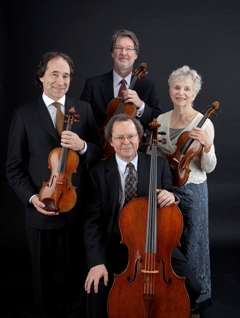|
Back
Bach in the Round Washington
National Museum of American History
05/04/2019 - & May 5, 2019
Johann Sebastian Bach: Die Kunst der Fuge, BWV 1080
The Axelrod String Quartet: Marc Destrubé, Marilyn McDonald (violin), James Dunham (viola), Kenneth Slowik (cello)

The Axelrod String Quartet
The Axelrod String Quartet, one of the Smithsonian Chamber Music Society’s house ensembles, believes that a good way to draw the audience in to Bach’s dauntingly rigorous The Art of Fugue is to play it from within the audience’s midst, quite literally. For last night’s concert, the ensemble set up shop in the middle of the Hall of Music at the National Museum of American History, with seats placed around it on all sides at a close distance. This certainly served to heighten the immediacy of music whose suitability for public performance has not infrequently been called into question. Bach presents us with a veritable catalogue of sophisticated contrapuntal techniques in a series of more than a dozen fugues essentially built upon a single theme; no instrumentation is identified in the original score, which has fueled speculation that this music was conceived primarily as an academic exercise. Certainly it can be exhausting to listen to in a way that The Well-Tempered Clavier, with its preludes interspersed among the fugues, is not—yet, strikingly, as the contrapuncti of The Art of Fugue increase in complexity, Bach gradually introduces counter-themes of a somewhat more lyrical and ingratiating character than the original theme. However, one still has to follow a good deal of quite dense counterpoint for over an hour with little respite, but especially in live performance there can be something exhilarating about it if everything comes together well.
A special challenge in performing this work lies in its competing demands for extreme clarity and listenability. One reason to arrange this music for small ensembles (or even a chamber orchestra) rather than for solo keyboard is that the greater variety of color, texture, and expressive possibility gives the audience something to hang on to, as it were; some sense of a human dimension. Yet if color or expression is allowed to overwhelm the carefully wrought counterpoint, there is not much left to hear in the piece. Fortunately, the Axelrod Quartet—playing on gut strings yet with a basically modern style—negotiated adroitly between the Scylla and Charybdis of the work. Vibrato was frequent but not intrusively so, creating a sense of singing warmth without obscuring linear clarity or reducing the music to mush. Still more importantly, the players (named individually above; experienced quartet aficionados may remember James Dunham as the last violist of the Cleveland Quartet, and the others, distinguished musicians all, have long been involved in early music performance) consistently phrased in an expressive—and often dramatic—manner. Nothing was overly anemic or “analytic,” yet details still fell nicely into place. The Art of Fugue does not represent Bach at his most purely lovable, but the Axelrod Quartet reminded us that it in that right hands, it does repay with its own subtle joys the patience it demands of the listener.
Samuel Wigutow
|